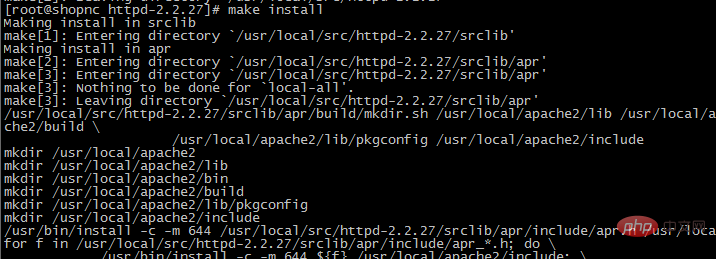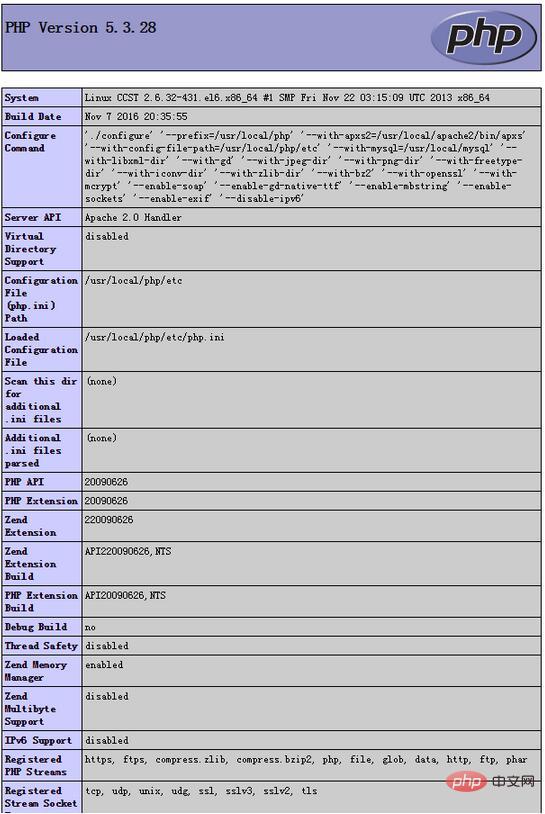

Einrichtungs- und Konfigurationsschritte für die PHP-Umgebung:
1 🎜 >

2. Laden Sie das Softwarepaket herunter/ändern Sie die Quelle
(1) Laden Sie das Softwarepaket herunter und installieren Sie esyum install -y wget vim unzip zip

rpm -e epel-release
2. Yum Cache löschen
yum alles reinigen
 yum Makecache
yum Makecache
3. rm -rf /etc/yum.repos.d/* (Denken Sie bei der Durchführung dieses Vorgangs daran, wget im Voraus zu installieren, andernfalls müssen Sie die CD mounten und rpm verwenden, um wget zu installieren.)
 4. Ali-Quelle herunterladen
4. Ali-Quelle herunterladen
wget -P /etc/yum.repos.d/ http://mirrors.aliyun.com/repo/epel -6.repohttp://mirrors .aliyun.com/repo/Centos-6.repo
5,
yum repolist
 Verwandte Empfehlungen: „
Verwandte Empfehlungen: „
(1) Entpacken Sie
tar -zxvf mysql-5.1.72-linux- x86_64-glibc23.tar.gz
 (2) MySQL konfigurieren
(2) MySQL konfigurieren
mv mysql-5.1.72-linux-x86_64-glibc23 /usr/local/mysql cd /usr/local/mysql useradd -s /sbin/nologin mysql mkdir -p /data/mysql chown -R mysql:mysql /data/mysql
./scripts/mysql_install_db --user =mysql --datadir=/data /mysql
Überprüfen Sie, ob die Kompilierung erfolgreich ist
echo $?
 (3) Machen MySQL in einen Dienst
(3) Machen MySQL in einen Dienst
cp support-files/my-large.cnf /etc/my.cnf cp support-files/mysql.server /etc/init.d/mysqld chmod 755 /etc/init.d/mysqld vim /etc/init.d/mysqld
Dateiinhalt ändern
basedir=/usr/local/mysql (MySQL-Installationsverzeichnis)
datadir=/data/mysqlMySQL-Datenbankverzeichnis)
chkconfig --add mysqld
chkconfig mysqld on
4. Installieren Sie Apache(1) Installieren Sie die Software-Ausführungsumgebung gcc
yum install -y gcc
 (2) Entpacken Sie
(2) Entpacken Sie
tar -jxvf httpd-2.2.27.tar.bz2
 (3 )Kompilieren
(3 )Kompilieren
./configure --prefix=/usr/local/apache2 --enable-mods-shared=most --enable-so
 (4) Installieren
(4) Installieren
make
 make install
make install

(1) Entpacken Sie
tar -zxvf php-5.3.28.tar.gz
 (2) Installieren Sie das für PHP erforderliche Software-Plug-in
(2) Installieren Sie das für PHP erforderliche Software-Plug-in
yum install -y libxml2-devel.x86_64 yum install -y openssl-devel.x86_64 yum install -y bzip2-devel.x86_64 yum install -y libjpeg-turbo-devel.x86_64 yum install -y libpng-devel.x86_64 yum install -y freetype-devel.x86_64 yum install -y libmcrypt-devel.x86_64
 (3) Kompilieren Sie den
(3) Kompilieren Sie den
-Code wie folgt:
./configure --prefix=/usr/local/php --with-apxs2=/usr/local/apache2/bin/apxs --with-config-file-path=/usr/local/php/etc --with-mysql=/usr/local/mysql --with-libxml-dir --with-gd --with-jpeg-dir --with-png-dir --with-freetype-dir --with-iconv-dir --with-zlib-dir --with-bz2 --with-openssl --with-mcrypt --enable-soap --enable-gd-native-ttf --enable-mbstring --enable-sockets --enable-exif --disable-ipv6
 (4) Installieren Sie
(4) Installieren Sie
make

make install

六、编辑配置文件
(1)vim /usr/local/apache2/conf/httpd.conf找到:
<Directory /> Options FollowSymLinks AllowOverride None Order deny,allow Deny from all </Directory>
改为:
<Directory /> Options FollowSymLinks AllowOverride None Order deny,allow Allow from all </Directory>
找到:
AddType application/x-gzip .gz .tgz
在该行下面添加:
AddType application/x-httpd-php .php
找到:
<IfModule dir_module> DirectoryIndex index.html </IfModule>
将该行改为:
<IfModule dir_module> DirectoryIndex index.html index.htm index.php </IfModule>
找到:
#ServerName www.example.com:80
修改为:
ServerName localhost:80
2 测试解析php
vim /usr/local/apache2/htdocs/1.php
写入:
<?php phpinfo(); ?>
浏览器打开:地址/1.php

Das obige ist der detaillierte Inhalt vonSo konfigurieren Sie die PHP-Laufumgebung. Für weitere Informationen folgen Sie bitte anderen verwandten Artikeln auf der PHP chinesischen Website!
 So öffnen Sie eine PHP-Datei
So öffnen Sie eine PHP-Datei
 So entfernen Sie die ersten paar Elemente eines Arrays in PHP
So entfernen Sie die ersten paar Elemente eines Arrays in PHP
 Was tun, wenn die PHP-Deserialisierung fehlschlägt?
Was tun, wenn die PHP-Deserialisierung fehlschlägt?
 So verbinden Sie PHP mit der MSSQL-Datenbank
So verbinden Sie PHP mit der MSSQL-Datenbank
 So verbinden Sie PHP mit der MSSQL-Datenbank
So verbinden Sie PHP mit der MSSQL-Datenbank
 Konfigurieren Sie die Java-Laufzeitumgebung
Konfigurieren Sie die Java-Laufzeitumgebung
 So laden Sie HTML hoch
So laden Sie HTML hoch
 So lösen Sie verstümmelte Zeichen in PHP
So lösen Sie verstümmelte Zeichen in PHP